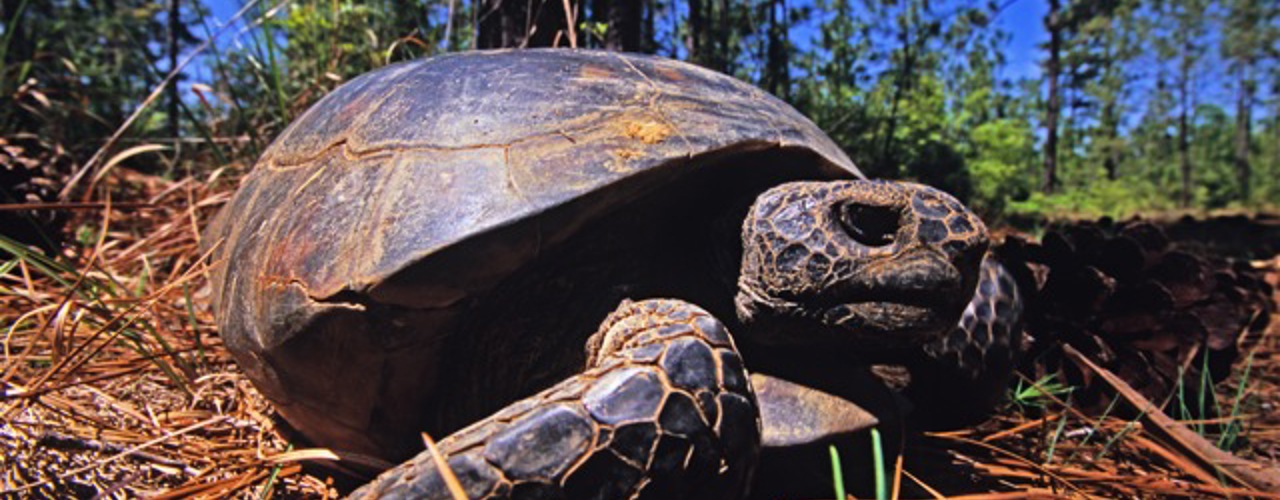

USDA Launches Strategy to Continue Conserving the Gopher Tortoise and its Critical Habitat
The U.S. Department of Agriculture’s (USDA) Natural Resources Conservation Service (NRCS) released its new 5-year plan to conserve the Southeast’s threatened gopher tortoise by focusing on the conservation and restoration of its key habitat―longleaf pine forests, and fire will play a leading role in the efforts. The initiative has already conserved 274,302 acres of gopher tortoise habitat since 2017, and the new plan’s goal is to conserve an additional 975,687 acres by the end of 2024. The gopher tortoise is one of nine species to represent the USDA’s premier wildlife conservation program―Working Lands for Wildlife (WLFW).
“With Working Lands for Wildlife, we’re able to develop successful solutions for both wildlife and landowners,” said Acting NRCS Chief Kevin Norton, who introduced the new strategy in a conservation outcomes webinar today. “In the case of the gopher tortoise, it’s about much more than this one species, since so many others, like insects, rabbits, and quail, greatly benefit from the restoration of the tortoise’s habitat.”
The fate of the gopher tortoise is linked to habitat quality, and efforts to conserve habitat on private lands will be critical to its continued survival. WLFW conservation actions are based on resource needs and generally prioritize the following:
- Promoting increased use of prescribed burning
- Improving vegetation management to include both timber stand and understory management
- Establishing longleaf pine stands through plantings
- Supporting prescribed grazing to manage gopher tortoise habitats in pine savannas and grasslands
WLFW worked with partners in 2016 to identify priority areas for conservation based on where gopher tortoises were known to occur, appropriate soils, and vegetation. Knowing these priority areas is critical for strategic conservation action. In 2017, NRCS released the very first implementation plan for WLFW-gopher tortoise, which set a goal of 205,000 acres of conservation practices to support gopher tortoise recovery but exceeded it by the end of 2018. By 2019 their implementation reached more than 274,300 acres of gopher tortoise habitat.
This new Gopher Tortoise FY 2020 – 2024 Implementation Strategy will build upon those successes and prescribed burning will be the dominant conservation action in this new strategy to recover quality habitats and promote healthy native forest stands. Prescribed burns every 2-3 years are critical to creating and maintaining gopher tortoise habitat needs in pine forests―they are an effective way to control understory competition, promote soft forage plants and allow young gopher tortoise to easily move through the forest. NRCS estimates 740,950 acres of prescribed burns over the 5-year term of this plan.
As longleaf pine stands mature, timber thinning harvests will be critical to allowing individual trees room to grow and to bring sunlight to the forest floor. Sunlight promotes growth of soft ground vegetation for gopher tortoise grazing and it incubates their nests. The estimate for forest stand improvement is 89,754 acres by 2024.
Other vegetation management practices, such as brush management and invasive species control, will contribute about 30,081 acres to the next 5-year milestone goals. Prescribed grazing management will contribute another 48,474 acres of habitat by 2024. Prescribed grazing was included in the previous implementation strategy for gopher tortoise but was limited to Florida. Now this practice will be used to improve gopher tortoise habitats in Louisiana and Mississippi as well.
Also included in this new implementation strategy are conservation easements totaling 27,500 acres to be secured in Florida, Alabama, and Georgia.
This strategy represents a sustained 13-year effort by USDA to promote restoration of the longleaf pine ecosystem and recovery of its keystone species the gopher tortoise. Learn more about USDA’s wildlife conservation efforts with Working Lands for Wildlife.
--
Originally published by USDA NRCS
Learn More
Understanding the keystone gopher tortoise
Understanding and proactively strategizing to slow the population decline of the gopher tortoise






